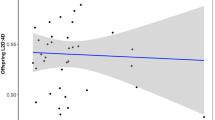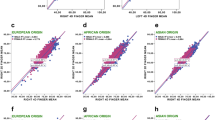Measuring people's finger patterns may reveal some surprising information.
Abstract
Animal models have indicated that androgenic steroids acting before birth might influence the sexual orientation of adult humans. Here we examine the androgen-sensitive pattern of finger lengths1, and find evidence that homosexual women are exposed to more prenatal androgen than heterosexual women are; also, men with more than one older brother, who are more likely than first-born males to be homosexual in adulthood2, are exposed to more prenatal androgen than eldest sons. Prenatal androgens may therefore influence adult human sexual orientation in both sexes, and a mother's body appears to ‘remember’ previously carried sons, altering the fetal development of subsequent sons and increasing the likelihood of homosexuality in adulthood.
This is a preview of subscription content, access via your institution
Access options
Subscribe to this journal
Receive 51 print issues and online access
$199.00 per year
only $3.90 per issue
Buy this article
- Purchase on Springer Link
- Instant access to full article PDF
Prices may be subject to local taxes which are calculated during checkout

Similar content being viewed by others
References
Manning, J. T., Scutt, D., Wilson, J. & Lewis-Jones, D. I. Hum. Reprod. 13, 3000–3004 ( 1998).
Blanchard, R. Annu. Rev. Sex Res. 8, 27–67 (1997).
Breedlove, S. M., Cooke, B. M. & Jordan, C. L. Brain Behav. Evol. 54, 8– 14 (1999).
Manning, J. T., Trivers, R .L., Singh, D. & Thornhill, R. Nature 399, 214–215 ( 1999).
McFadden, D. & Pasanen, E. Proc. Natl Acad. Sci. USA 95, 2709–2713 (1998).
James, W. H. Hum. Biol. 59, 721–752 ( 1987).
Bogaert, A. F. Behav. Neurosci. 111, 1395–1397 (1997).
Bailey, J. M. & Pillard, R. C. Arch. Gen. Psychiatry 48, 1089–1096 (1991).
Hamer, D. D., Hu, S., Magnuson, V. L., Hu, N. & Pattatucci, A. M. L. Science 261, 321– 327 (1993).
Gorman, M. R. Persp. Biol. Med. 38, 61–81 (1994).
Brodie, H. K. H. et al. Am. J. Psychiatry 131, 82– 83 (1974).
Mayer-Bahlburg, H. F. L. Progr. Brain Res. 61, 375–398 (1984).
Bogaert, A. F. & Hershberger, S. Arch. Sexual Behav. 28, 213–221 ( 1999).
McFadden, D. & Champlin, C. A. J. Ass. Res. Otolaryngol. (in the press).
Author information
Authors and Affiliations
Corresponding author
Rights and permissions
About this article
Cite this article
Williams, T., Pepitone, M., Christensen, S. et al. Finger-length ratios and sexual orientation. Nature 404, 455–456 (2000). https://doi.org/10.1038/35006555
Issue Date:
DOI: https://doi.org/10.1038/35006555
This article is cited by
-
Digit Ratio (2D:4D; Right-Left 2D:4D) and Multiple Phenotypes for Same-Sex Attraction: The BBC Internet Study Revisited
Archives of Sexual Behavior (2024)
-
An anthropometric study of sexual orientation and gender identity in Thailand
Scientific Reports (2021)
-
2D:4D Digit Ratios in Adults with Gender Dysphoria: A Comparison to Their Unaffected Same-Sex Heterosexual Siblings, Cisgender Heterosexual Men, and Cisgender Heterosexual Women
Archives of Sexual Behavior (2021)
-
Digit ratio (2D:4D) and transgender identity: new original data and a meta-analysis
Scientific Reports (2020)
-
2D:4D Suggests a Role of Prenatal Testosterone in Gender Dysphoria
Archives of Sexual Behavior (2020)
Comments
By submitting a comment you agree to abide by our Terms and Community Guidelines. If you find something abusive or that does not comply with our terms or guidelines please flag it as inappropriate.



